![]()
![]()
![]()
Use LEFT and RIGHT arrow keys to navigate between flashcards;
Use UP and DOWN arrow keys to flip the card;
H to show hint;
A reads text to speech;
52 Cards in this Set
- Front
- Back
|
Power, influence and leadership |
Leadership is the use of power and influence to direct the activities of followers toward goal achievement. Power is the ability to influence the behavior of others and resist unwanted influence in return. Power is necessary, in that it gives leaders the ability to influence others.
|
|
|
Bases of power – organizational and personal |
Leaders have five major types of power. There are three organizational forms of power: Legitimate power is based on authority or position, reward power is based on the distribution of resources or benefits, and coercive power is based on the handing out of punishments.
There are two personal forms of power: Expert power is derived from expertise and knowledge, whereas referent power is based on the attractiveness and charisma of the leader. These types of power can be used most effectively when leaders are central to the work process, highly visible, have discretion, and are the sole controllers of resources and information.
|
|
|
What can make a leader’s ability to influence others increase? |
Leaders can use at least 10 different influence tactics to achieve their objectives. The most effective are rational persuasion, consultation, inspirational appeals, and collaboration. The least effective are pressure and the forming of coalitions. Tactics with moderate levels of effectiveness are ingratiation, exchange, personal appeals, and apprising.
|
|
|
Rational persuasion |
is the use of logical arguments and hard facts to show the target that the request is a worthwhile one.
|
|
|
Inspirational appeal |
is a tactic designed to appeal to the target’s values and ideals, thereby creating an emotional or attitudinal reaction.
|
|
|
Consultation |
occurs when the target is allowed to participate in deciding how to carry out or implement a request. |
|
|
Collaboration |
Collaboration could involve the leader helping complete the task, providing required resources, or removing obstacles that make task completion difficult.
|
|
|
Ingratiation |
is the use of favors, compliments, or friendly behavior to make the target feel better about the influencer. |
|
|
Personal appeals |
occur when the requestor asks for something based on personal friendship or loyalty. The stronger the friendship, the more successful the attempt is likely to be.
|
|
|
Exchange tactic |
is used when the requestor offers a reward or resource to the target in return for performing a request.
|
|
|
Apprising |
occurs when the requestor clearly explains why performing the request will benefit the target personally. |
|
|
engagement |
|
|
|
compliance |
occurs when targets of influence are willing to do what the leader asks, but they do it with a degree of ambivalence. Compliance reflects a shift in the behaviors of employees but not their attitudes. |
|
|
resistance |
occurs when the target refuses to perform the influence request and puts forth an effort to avoid having to do it. Employee resistance could come in the form of making excuses, trying to influence the requestor in return, or simply refusing to carry out the request.
|
|
|
Organizational Politics and political skill |
Organizational politics can be seen as actions by individuals that are directed toward the goal of furthering their own self-interests. Political skill is the ability to effectively understand others at work and use that knowledge to influence others in ways that enhance personal and/or organizational objectives. |
|
|
personal need for power and Machiavellianism |
Power and influence have moderate positive relationships with job performance and organizational commitment. However, for these beneficial effects to be realized, leaders must wield their power effectively and rely on effective influence tactics in negotiating outcomes. |
|
|
Competing |
(high assertiveness, low cooperation) occurs when one party attempts to get his or her own goals met without concern for the other party’s results. It could be considered a win–lose approach to conflict management. Competing occurs most often when one party has high levels of organizational power and can use legitimate or coercive power to settle the conflict. |
|
|
Avoiding |
(low assertiveness, low cooperation) occurs when one party wants to remain neutral, stay away from conflict, or postpone the conflict to gather information or let things cool down. Avoiding usually results in an unfavorable result for everyone, including the organization, and may result in negative feelings toward the leader. Most important, avoiding never really resolves the conflict. |
|
|
Accommodating |
(low assertiveness, high cooperation) occurs when one party gives in to the other and acts in a completely unselfish way. Leaders will typically use an accommodating strategy when the issue is really not that important to them but is very important to the other party. It’s also an important strategy to think about when the leader has less power than the other party. |
|
|
Collaboration |
(high assertiveness, high cooperation) occurs when both parties work together to maximize outcomes. Collaboration is seen as a win–win form of conflict resolution. Collaboration is generally regarded as the most effective form of conflict resolution, especially in reference to task-oriented rather than personal conflicts. |
|
|
Compromise |
(moderate assertiveness, moderate cooperation) occurs when conflict is resolved through give-and-take concessions. Compromise is perhaps the most common form of conflict resolution, whereby each party’s losses are offset by gains and vice versa. It is seen as an easy form of resolution, maintains relations between parties, and generally results in favorable evaluations for the leader. women are more likely to use this as a tactic |
|
|
Effects of Power and Influence on Performanceand Commitment |
moderate positive as it can increase engagement andcompliance and therefore affect performance and commitment |
|
|
What is leader-member exchange theory |
describes how leader–member relationships develop over time on a dyadic basis, can explain why those differences exist. The theory argues that new leader–member relationships are typically marked by a role taking phase, during which a manager describes role expectations to an employee and the employee attempts to fulfill those expectations with his or her job behaviors. In this period of sampling and experimentation, the leader tries to get a feel for the talent and motivation levels of the employee. For some employees, that initial role taking phase may eventually be supplemented by role making , during which the employee’s own expectations for the dyad get mixed in with those of the leader. The role making process is marked by a free-flowing exchange in which the leader offers more opportunities and resources and the employee contributes more activities and effort.
|
|
|
Leader Decision-Making Styles (4 types) |
autocratic style , the leader makes the decision alone without asking for the opinions or suggestions of the employees in the work unit. consultative style , the leader presents the problem to individual employees or a group of employees, asking for their opinions and suggestions before ultimately making the decision him- or herself. facilitative style , in which the leader presents the problem to a group of employees and seeks consensus on a solution, making sure that his or her own opinion receives no more weight than anyone else’s. delegative style , the leader gives an individual employee or a group of employees the responsibility for making the decision within some set of specified boundary conditions. |
|
|
Time Driven Model of Leadership – what are the sevenfactors? |
• Decision significance: Is the decision significant to the success of the project or the organization? • Importance of commitment: Is it important that employees “buy in” to the decision? • Leader expertise: Does the leader have significant knowledge or expertise regarding the problem? • Likelihood of commitment: How likely is it that employees will trust the leader’s decision and commit to it? • Shared objectives: Do employees share and support the same objectives, or do they have an agenda of their own? • Employee expertise: Do the employees have significant knowledge or expertise regarding the problem? • Teamwork skills: Do the employees have the ability to work together to solve the problem, or will they struggle with conflicts or inefficiencies?
|
|
|
Initiating Structure and Consideration |
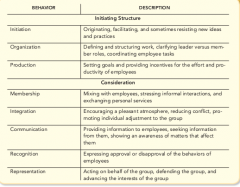
|
|
|
Life Cycle Theory of Leadership (styles) and readiness of followers |
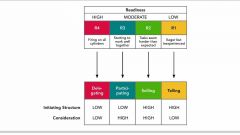
The life cycle theory of leadership (sometimes also called the situational model of leadership ) argues that the optimal combination of initiating structure and consideration depends on the readiness of the employees in the work unit. |
|
|
Transformational Leadership – its four dimensions |
Transformational leadership involves inspiring followers to commit to a shared vision that provides meaning to their work while also serving as a role model who helps followers develop their own potential and view problems from new perspectives. Transformational leaders heighten followers’ awareness of the importance of certain outcomes while increasing their confidence that those outcomes can be achieved. What gets “transformed” is the way followers view their work, causing them to focus on the collective good more than just their own short-term self-interests and to perform beyond expectations as a result. |
|
|
Substitutes for Leadership and neutralizers |
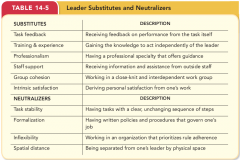
Substitutes reduce the importance of the leader while simultaneously providing a direct benefit to employee performance. For example, a cohesive work group can provide its own sort of governing behaviors, making the leader less relevant, while providing its own source of motivation Neutralizers , in contrast, only reduce the importance of the leader; they themselves have no beneficial impact on performance. For example, spatial distance lessens the impact of a leader’s |
|
|
Effects of Transformational Leadership on Performance |
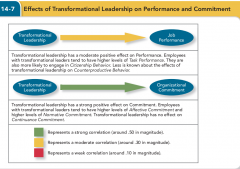
|
|
|
Elements of organizational structure (all 5) |
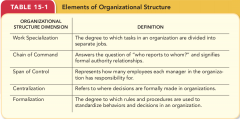
|
|
|
organizational structure and chart |
An organization’s structure formally dictates how jobs and tasks are divided and coordinated between individuals and groups within the organization. This structure, partially illustrated through the use of organizational charts, provides the foundation for organizing jobs, controlling employee behavior, shaping communication channels, and providing a lens through which employees view their work environment. |
|
|
Bureaucracy – characteristics & what are they designed for? |
A bureaucratic structure is an organizational form that exhibits many of the facets of the mechanistic organization. Bureaucracies are designed for efficiency and rely on high levels of work specialization, formalization, centralization of authority, rigid and well-defined chains of command, and relatively narrow spans of control. As mentioned previously, as an organization’s size increases, it’s incredibly difficult not to develop some form of bureaucracy. |
|
|
Mechanistic vs. organic structures |
Mechanistic organizations are efficient, rigid, predictable, and standardized organizations that thrive in stable environments. Mechanistic organizations are typified by a structure that relies on high levels of formalization, a rigid and hierarchical chain of command, high degrees of work specialization, centralization of decision making, and narrow spans of control. In contrast, organic organizations are flexible, adaptive, outward-focused organizations that thrive in dynamic environments. Organic organizations are typified by a structure that relies on low levels of formalization, weak or multiple chains of command, low levels of work specialization, and wide spans of control. |
|
|
Organizational Design: strategy, technology, size |
Organizational design is the process of creating, selecting, or changing the structure of an organization. Factors to be considered in organizational design include a company’s business environment, its strategy, its technology, and its size. |
|
|
Simple structures |
Simple structures are perhaps the most common form of organizational design, primarily because there are more small organizations than large ones. In fact, more than 80 percent of employing organizations have fewer than 19 employees. Small accounting and law firms, family-owned grocery stores, individual-owned retail outlets, independent churches, and landscaping services are all organizations that are likely to use a simple structure. |
|
|
Functional structure |
a functional structure groups employees by the functions they perform for the organization. For example, employees with marketing expertise are grouped together, those with finance duties are grouped together, and so on. The success of the functional structure is based on the efficiency advantages that come with having a high degree of work specialization that’s centrally coordinated. |
|
|
Divisional structures (multi-divisional): product,geographic, client-based |
Product structures group business units around different products that the company produces. Geographic structures are generally based around the different locations where the company does business. client structure, When organizations have a number of very large customers or groups of customers that all act in a similar way, they might organize their businesses around serving those customers. |
|
|
Matrix structure |
Matrix structures are more complex designs that try to take advantage of two types of structures at the same time. Companies such as Xerox, General Electric, and Dow Corning were among the first to adopt this type of structure. |
|
|
What does structure affect? |
Organizational restructuring efforts have a weak negative effect on job performance. They have a more significant negative effect on organizational commitment, because employees tend to feel less emotional attachment to organizations that are restructuring. |
|
|
Emergent structures – why? |
|
|
|
Do we know what impact structure has on job perf. or org commitment? |
Organizational restructuring efforts have a weak negative effect on job performance. They have a more significant negative effect on organizational commitment, because employees tend to feel less emotional attachment to organizations that are restructuring. |
|
|
Organizational culture – what is it? |
define organizational culture as the shared social knowledge within an organization regarding the rules, norms, and values that shape the attitudes and behaviors of its employees. |
|
|
Artifacts, symbols, structures, language, stories, rituals,ceremonies |
Observable artifacts are the manifestations of an organization’s culture that employees can easily see or talk about. They supply the signals that employees interpret to gauge how they should act during the workday. Symbols can be found throughout an organization, from its corporate logo to the images it places on its website to the uniforms its employees wear. Think about what Nike’s “swoosh” represents: speed, movement, velocity. Physical structures also say a lot about a culture. Is the workplace open? Does top management work in a separate section of the building? Is the setting devoid of anything unique, or can employees express their personalities? Language reflects the jargon, slang, and slogans used within the walls of an organization. Stories consist of anecdotes, accounts, legends, and myths that are passed down from cohort to cohort within an organization. Rituals are the daily or weekly planned routines that occur in an organization. Employees at New Belgium Brewing in Colorado, home of Fat Tire Ale, can enjoy a beer in the tasting room after their shift as well as get one free twelve-pack a week, conveying the importance of both employees and the company’s product. Ceremonies are formal events, generally performed in front of an audience of organizational members. At Care.com , all workers are forced to move desks every year at the same time. CEO Sheila Marcelo assigns the seats. |
|
|
Espoused values |
Espoused values are the beliefs, philosophies, and norms that a company explicitly states. Espoused values can range from published documents, such as a company’s vision or mission statement, to verbal statements made to employees by executives and managers. |
|
|
Types of cultures: Communal, networked, mercenary, fragments |
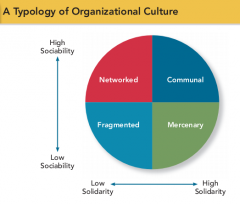
Organizations that are low on both dimensions have a fragmented culture in which employees are distant and disconnected from one another. Organizations that have cultures in which employees think alike but aren’t friendly to one another can be considered mercenary cultures . These types of organizations are likely to be very political, “what’s in it for me” environments. Cultures in which all employees are friendly to one another, but everyone thinks differently and does his or her own thing, are networked cultures . Many highly creative organizations have a networked culture. Organizations with friendly employees who all think alike are communal cultures . There is some evidence that organizations have a tendency to move through the cultures as they get larger. Small organizations generally start out as communal cultures oriented around the owner and founder. As companies grow, they tend to move toward a networked culture, because solidarity is harder to foster when groups get really large. Although we like to think of culture as being stable, it can change, as we discuss later in this chapter. |
|
|
Specific types: customer service, safety, diversity,creativity |
customer service culture focused on service quality. After all, 80 percent of the gross domestic product in the United States is generated by service-based organizations. It’s not uncommon for manufacturing or medical companies to go through a string of accidents or injuries that potentially harm their employees. For these organizations, creating a safety culture is of paramount importance. Diversity, help create a culture of diversity. Given the importance of new ideas and innovation in many industries, it’s understandable that some organizations focus on fostering a creativity culture |
|
|
Culture strength – strong and weak (pros and cons) |

|
|
|
Sub-cultures |
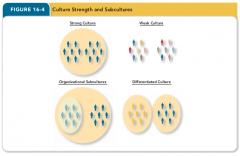
|
|
|
Effects of Person-org fit on performance and commitment |
Person–organization fit is the degree to which a person’s values and personality match the culture of the organization. Person–organization fit has a weak positive effect on job performance and a strong positive effect on organizational commitment. |
|
|
How does a company maintain a culture? Socialization and managing it |
Organizations maintain their cultures through attraction, selection, and attrition processes and socialization practices. Organizations change their cultures by changing their leadership or through mergers and acquisitions. |
|
|
How does an organization change its culture? |
There are a number of practices organizations can utilize to improve the socialization of new employees, including realistic job previews, orientation programs, and mentoring. |

